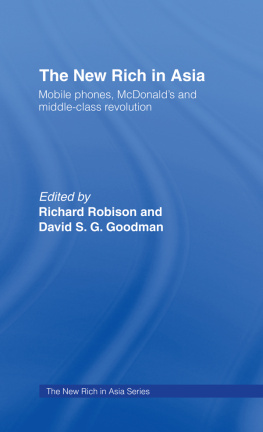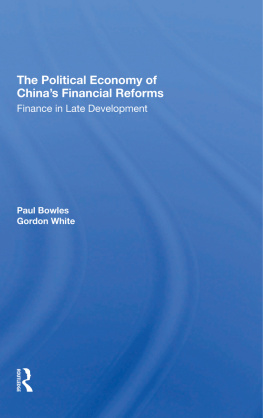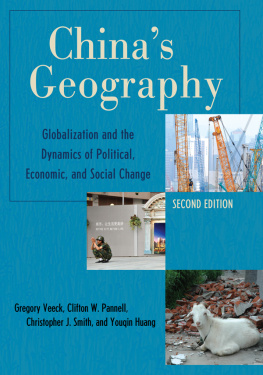
Chinas provinces in reform
Chinas provinces are all considerable social, economic and political systems in their own right, and most are the size and scale of a European country in population, land area and social complexity; under other circumstances they might well be regarded as separate states, rather than component parts of a single, unitary system. Despite their distinct identities and importance to the countrys social, political and economic development, Chinas provinces only recently became a major focus of inquiry with the introduction of reform and decentralisation.
This volume is the first of a series examining each of Chinas provinces in reform and deals with Guangxi, Hainan, Liaoning, Shandong, Shanghai, Sichuan and Zhejiang. It is concerned with the impact of economic reform on social and political change within each of the provinces. The issues revealed by this study are not only the determinants of provincial politics of central-provincial relations in China, but also wider concerns about the impact of economic modernisation on social and political change. The seven cases presented here highlight the effects of economic growth on class formations, regional development within each province and emergent political cultures, particularly those related to questions of local identity.
Chinas Provinces in Reform is the first of a series that will provide an authoritative and comprehensive survey of Chinas regional politics. As such it will be essential reading for all those concerned with the impact of the reform era.
David S.G.Goodman is Director of the Institute for International Studies, University of Technology, Sydney.
Chinas provinces in reform
Class, community and political culture
Edited by David S.G.Goodman
First published 1997
by Routledge
11 New Fetter Lane, London EC4P 4EE
This edition published in the Taylor & Francis e-Library, 2003.
Simultaneously published in the USA and Canada
by Routledge
29 West 35th Street, New York, NY 10001
1997 Selection and editorial matter, the Institute for International Studies, UTS;
individual chapters, the contributors
All rights reserved. No part of this book may be reprinted or reproduced or utilised in any form or by any electronic, mechanical, or other means, now known or hereafter invented, including photocopying and recording, or in any information storage or retrieval system, without permission in writing from the publishers.
British Library Cataloguing in Publication Data
A catalogue record for this book is available from the British Library
Library of Congress Cataloguing in Publication Data
A catalogue record for this book has been requested
ISBN 0-203-44539-2 Master e-book ISBN
ISBN 0-203-75363-1 (Adobe eReader Format)
ISBN 0-415-16403-6 ( hb)
ISBN 0-415-16404-4 ( pbk)
Maps
Tables
Provincial GVIO by ownership system, 1994
Districts in Guangdong: GVIO by ownership system, 1990
Guangxis subsidies from central government, 197893
Guangxis border trade, 198994
Economic growth in Liaoning and other selected provinces, 195390
Sectoral shares of Liaonings GVIAO, 1957 and 1993
Liaoning GVIO growth rates: enterprises by ownership structure, 198994
Growth rates of four key indicators in Shandong, 194994
Privileges of coastal and inland regions in Shandong, 1994
Coastal-inland comparison for selected economic indicators, 1994
Foreign direct investment in Shandong by city, 19924
Regional distribution of poor counties, 1994
Sixty province-designated development zones in Shandong, 1994
Select cases of four-directional pairing in Shandong
GDP growth rates: China and Shanghai, 197893
The structure of the Shanghai economy by sector, 195293
Percentage of light and heavy industry in Shanghai economy, 197893
Changes in the structure of Shanghais industry, 1990 and 1993
Value of stocks and bonds traded in Shanghai, 19924
Value of futures traded in Shanghai, 1993 and 1994
Retail sales in Shanghai, 19904
Living space per capita in Shanghai urban areas, 195293
Living space per capita in urban areas of selected Chinese cities, 1993
Size of transient population in Shanghai, 198293
Shanghai leadership, end of 1995
Economic performance of Sichuan in China, 1993
Economic figures per capita for Sichuan, 1993
Fourteen regions of China that attracted most foreign investment, 1993
Seven regions with largest investment in fixed assets by ownership, 1993
Annual rates of increase in major indices: Zhejiang and China, 197993
Zhejiangs economy: major sectoral proportions, 195294
Zhejiangs economy: key proportions, 197894
Zheijiangs ownership proportions, 197894
Foreign trade and investment in Zhejiang, 197994
Contributors
Feng Chongyi is Lecturer in China Studies at the Institute for International Studies, University of Technology, Sydney. He is the author of PeasantConsciousness and China (Chung Hwa Book, Hong Kong, 1989), BertrandRussell and China ( Sanlian Shudian, Beijing, 1994) and (with David S.G. Goodman) Chinas Hainan Province: Economic Development and InvestmentEnvironment (University of Western Australia Press, 1995). He was formerly Associate Professor of History, Nankai University, Tianjin.
Jae Ho Chung is Assistant Professor in Chinese Politics in the Department of International Relations at Seoul National University, Korea. He has contributed to The China Quarterly, Studies in Comparative Communism and Pacific Affairs and co-edited The Emergence of East Asia: Bilateral Dynamicsof the Region and Multilateral Issues of APEC (1995) and ProvincialStrategies of Economic Reform in Post-Mao China (1997).
Keith Forster teaches at Southern Cross University. His research interests lie in the contemporary politics and economics of China, and he has published widely on these subjects. He has published Rebellion and Factionalism in aChinese Province: Zhejiang, 19661976 (Sharpe, New York, 1990) and (with Dan Etherington) Green Gold: The Political Economy of Chinas Post-1949Tea Industry (Oxford University Press, New York, 1993). He taught at Hangzhou University for three years during the late 1970s and has made extensive research trips to Zhejiang every year since 1988.
David S.G.Goodman is Director of the Institute for International Studies, University of Technology, Sydney. His most recent publications include (with Richard Robison) The New Rich in Asia: Mobile phones, McDonalds andMiddle-Class Revolution ( Routledge, London, 1996), (with Gerald Segal) China Deconstructs: Politics, Trade and Regionalism ( Routledge, London, 1994) and Deng Xiaoping and the Chinese Revolution ( Routledge, London, 1994).
Hans Hendrischke is Director of the Access China Centre, Macquarie Graduate School of Management, Macquarie University. He has provided China-related consultancy to major manufacturers and financial institutions, and worked as a foreign business manager for a large leasing company pioneering financial cooperation with China. His research is on economic and political reforms in China.










